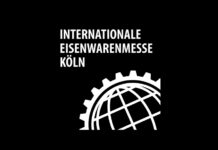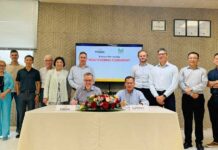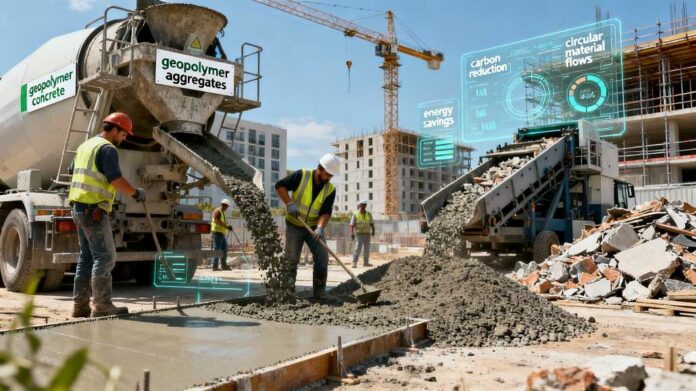The construction industry confronts an uncomfortable truth: traditional concrete production, dominated by ordinary Portland cement manufacturing, generates approximately two billion tons of carbon dioxide annually, representing roughly 8 percent of global emissions. Each ton of Portland cement produced releases approximately 0.8 tons of CO₂ into the atmosphere, creating massive environmental consequences that grow more untenable as global construction accelerates to address housing shortages and infrastructure demands. Yet innovative alternatives exist, offering pathways toward geopolymer recycled concrete systems that dramatically reduce environmental footprints while maintaining or exceeding conventional material performance. The emergence of geopolymer binders and recycled aggregates represents far more than incremental improvement; these technologies fundamentally reshape how construction materials circulate within economic systems, transforming waste into valuable resources and establishing genuine circular economy principles within the built environment.
Understanding Geopolymer Chemistry and Material Fundamentals
Geopolymers represent an entirely different class of cementitious materials compared to conventional Portland cement. Rather than relying on calcium silicate hydration reactions characteristic of traditional concrete, geopolymers employ aluminosilicate-rich precursor materials that undergo alkaline activation to form three-dimensional inorganic polymer networks. This fundamental distinction in chemistry enables dramatic advantages including rapid strength development, superior durability characteristics, and most significantly, substantially reduced carbon footprints. Geopolymer recycled concrete systems leverage industrial by-products and waste materials as precursor sources, closing material loops and creating true circular construction practices.
The geopolymerization process begins with aluminosilicate-containing materials including fly ash from coal combustion, ground granulated blast furnace slag from iron production, waste clay bricks, or recycled concrete powder itself. These materials are activated through contact with highly alkaline solutions comprising sodium hydroxide and sodium silicate. The chemical reactions triggered by this activation process differ fundamentally from those occurring in Portland cement hydration. Polymeric gels and siliceous frameworks form through condensation polymerization, creating binding matrices that develop strength over time as these gel structures densify and crystallize. The resulting geopolymer concrete exhibits dense microstructures, reduced porosity, and enhanced resistance to chemical attack, fire exposure, and thermal stresses compared to conventional alternatives.
Life cycle assessments comparing geopolymer recycled concrete to traditional Portland cement concrete reveal remarkable environmental advantages. Research demonstrates that switching from Portland cement concrete to geopolymer concrete reduces carbon emissions by 80 to 90 percent, with potential reductions exceeding this range when recycled and renewably-produced materials comprise the entire feedstock. A significant portion of these reductions stems from eliminating energy-intensive Portland cement manufacturing. Producing geopolymer concrete from ground granulated blast furnace slag utilizes approximately 40 percent less energy than Portland cement production. The alkaline activation process, while energy-consuming, consumes substantially less total energy than conventional cement clinker production and subsequent grinding operations.
Recycled Aggregates and Waste Material Integration
The integration of recycled aggregates into geopolymer concrete systems completes circular material pathways by transforming construction and demolition waste into valuable building components. Recycled aggregate concrete, produced from crushed waste concrete or recovered aggregates from demolished structures, conserves virgin natural resources while reducing mining environmental impacts. Compared to conventional aggregate production requiring energy-intensive quarrying, crushing, and processing of natural stone, recycled aggregate production recycles existing materials using similar processing equipment but without environmental degradation from resource extraction.
The quality and performance characteristics of recycled aggregate concrete depend significantly on the source material and recycling process thoroughness. When sourced from concrete meeting minimum compressive strength specifications around 20 megapascals, recycled aggregates demonstrate durability and load-bearing capacity comparable to natural stone alternatives. Recycled aggregate concrete exhibits slightly increased water absorption capacity, typically ranging from 3 to 9 percent compared to 1 to 2 percent for natural aggregates, and may demonstrate 10 to 30 percent reductions in compressive strength depending on source quality and recycling process. These performance variations are manageable through careful mix design and supplementary material selection, enabling recycled aggregate concrete to perform successfully in most structural applications.
The superior adhesion achieved between geopolymer paste and recycled aggregate surfaces enhances performance characteristics when combining these technologies. Since recycled aggregate itself comprises previously hydrated concrete, the chemical compatibility between recycled concrete powder acting as geopolymer precursor and recycled aggregate surfaces promotes strong bonding interfaces. The sharp edges of mechanically crushed aggregate enhance mechanical interlock with the geopolymer matrix. This combination produces geopolymer recycled concrete systems with homogeneous microstructures and reliable performance characteristics that rival or exceed conventional alternatives for many applications.
Economic analyses increasingly support recycled aggregate adoption despite initial cost considerations. While virgin quarried aggregates have traditionally commanded lower prices, recycled aggregates prove cost-effective through avoided mining and transportation costs. Many recycling facilities operate on mobile equipment transportable to demolition sites, eliminating or drastically reducing aggregate transportation distances compared to distant quarry operations. Life-cycle cost analyses examining total ownership costs over infrastructure service lives consistently demonstrate financial advantages for recycled aggregate approaches, particularly when environmental externalities receive inclusion in economic evaluations.
Circular Construction Systems and Economic Principles
Geopolymer recycled concrete embodies authentic circular economy principles by fundamentally reshaping how materials flow through construction systems. In linear economy models dominating traditional construction, virgin materials are extracted, processed, used in structures, and eventually landfilled as waste when buildings reach end-of-life. Circular economy approaches reimagine these flows, designing systems where building materials become resources continuously cycling through productive uses with minimal waste and environmental impact.
Implementing geopolymer recycled concrete systems requires rethinking entire construction industry infrastructure. Recycling facilities must be strategically located and properly equipped to process construction and demolition waste into usable aggregate and powder feedstocks. Precast facilities and ready-mix producers need training and equipment modifications to handle geopolymer concrete’s distinct material properties compared to Portland cement concrete. Designers must develop familiarity with geopolymer performance characteristics including early and late-age strength development, thermal properties, and durability performance under various exposure conditions. Despite these transitional challenges, the systemic benefits justify investments in circular economy infrastructure development.
Job creation represents a significant economic benefit accompanying circular construction system development. Recycling operations, collection and sorting facilities, geopolymer production plants, and supporting services generate employment opportunities throughout material processing supply chains. The distributed nature of recycling facilities, often sited to serve regional markets, creates local employment and reduces transportation emissions compared to centralized production models. Skills required for circular economy operations differ from traditional quarrying, encouraging workforce development and career pathway expansion within construction material industries.
The most compelling aspect of geopolymer recycled concrete emerges from recognition that adequate material feedstocks exist globally to sustain expanded adoption. Billions of tons of construction and demolition waste accumulate annually from structural demolition, renovation projects, and infrastructure replacement. Industrial by-products from cement, steel, and energy production generate massive quantities of fly ash, slag, and other materials unsuitable for traditional disposal. These abundant feedstocks, currently viewed as waste requiring landfill disposal, become valuable inputs for geopolymer production when circular economy systems develop appropriate collection, processing, and utilization infrastructure.
Performance Characteristics and Application Suitability
Geopolymer recycled concrete demonstrates exceptional performance across multiple dimensions relevant to structural and durability requirements. Compressive strength development typically proceeds more rapidly than Portland cement concrete, with significant strength gains achieved within hours rather than days for geopolymer formulations optimized for rapid strength development. This early strength capability enables accelerated construction schedules, formwork removal optimization, and rapid traffic opening for pavement applications. Later-age strength development continues, often producing ultimate compressive strengths exceeding conventional concrete specifications when properly proportioned.
Durability performance, perhaps the most compelling advantage of geopolymer recycled concrete systems, demonstrates resistance to environmental challenges that compromise conventional concrete. Reduced permeability characteristic of geopolymer microstructures limits water and chemical ingress that drives corrosion and deterioration in traditional concrete. Laboratory testing and limited field experience confirm exceptional resistance to sulfate attack, commonly responsible for concrete degradation in industrial and marine environments. Acid resistance exceeds conventional concrete, particularly for biogenic sulfuric acid associated with wastewater treatment infrastructure. Fire resistance, evaluated through thermal exposure testing, demonstrates superior performance with reduced spalling risks and maintained compressive strength compared to Portland cement concrete exposed to equivalent thermal conditions.
Thermal and dimensional stability of geopolymer recycled concrete improves performance compared to alternatives in applications susceptible to thermal cycling and environmental exposure variations. Lower coefficients of thermal expansion and reduced shrinkage characteristics typical of geopolymer systems minimize cracking risks and movement stresses that compromise durability and aesthetics. These properties prove particularly valuable for pavements and slabs exposed to extreme temperature variations, where conventional concrete exhibits cracking susceptibility.
The versatility of geopolymer systems accommodates diverse application requirements through mix design adjustments and material proportioning modifications. Achieving desired strength levels, workability characteristics, and performance properties requires understanding geopolymer chemistry and implementing systematic optimization approaches. Unlike Portland cement concrete where cement content primarily controls strength within limited ranges, geopolymer systems offer flexibility through adjusting alkaline solution concentration, water-glass to sodium-hydroxide ratios, and supplementary material proportions. This flexibility enables customization for specific project requirements without fundamental material property compromises.
Implementation Pathways and Market Evolution
Transitioning construction industries toward geopolymer recycled concrete systems requires coordinated evolution across multiple stakeholder categories including material suppliers, designers, contractors, regulators, and building owners. Supply chain development represents a critical prerequisite, establishing reliable sources of appropriately-processed feedstock materials and ensuring consistent quality throughout production chains. Regulatory framework adaptation, updating building codes and design standards to accommodate geopolymer materials, accelerates adoption by clarifying compliance pathways and performance verification methods. Market incentive mechanisms including carbon pricing, sustainability certification recognition, and public procurement preferences for low-carbon materials accelerate transition timelines.
Current market deployment concentrates in progressive regions prioritizing sustainability objectives and supporting innovative material adoption. European markets lead deployment driven by stringent carbon emission reduction targets and circular economy policy frameworks. Asian markets demonstrate growing interest, particularly in rapidly urbanizing regions confronting waste management challenges and environmental degradation from construction activities. North American adoption proceeds more gradually, though mounting infrastructure deterioration and increasing environmental consciousness suggest acceleration trajectories as regulatory frameworks mature and material costs decline through expanded production.
Cost considerations significantly influence adoption rates, though economic analyses incorporating total lifecycle costs consistently favor geopolymer recycled concrete approaches. Initial material costs may exceed traditional concrete by 20 to 30 percent, reflecting reduced production volumes, specialized manufacturing requirements, and developing supply chains. As production scales increase and market competition expands, unit costs are expected to decline toward parity with conventional concrete within coming decades. Broader adoption will accelerate this cost reduction trajectory through supply chain optimization, manufacturing efficiency improvements, and economy-of-scale benefits.
Government incentive programs directly influence adoption acceleration through multiple mechanisms including carbon tax structures favoring low-carbon materials, procurement preferences for public infrastructure projects, and research funding supporting technology development and demonstration projects. Tax incentives for companies deploying geopolymer systems, reduction or elimination of disposal fees for construction waste destined for recycling, and regulatory recognition of performance credentials all accelerate transitions toward circular construction practices.
Future Trajectories and Industry Transformation
The convergence of environmental imperatives, resource scarcity concerns, and technological maturation positions geopolymer recycled concrete as increasingly central to construction’s sustainable future. Market projections indicate the global geopolymer concrete market will expand dramatically over coming decades, with compound annual growth rates of 15 to 30 percent depending on regional context and adoption scenarios. These expansion rates reflect genuine material innovation significance rather than niche market phenomena, suggesting transition toward geopolymer systems becoming standard practice in construction rather than specialized alternatives.
Technological development continues enhancing geopolymer performance and expanding application ranges. Enhanced formulations achieving improved workability without compromising strength or durability expand concrete placement options and reduce construction complexity. Innovations addressing variable feedstock quality enable utilization of broader material streams, increasing available supplies and reducing costs. Research into self-healing geopolymer systems, incorporating biological or capsule-based healing mechanisms, promises extended infrastructure service lives and reduced maintenance requirements.
Integration with other emerging construction technologies multiplies geopolymer system value delivery. When combined with embedded sensor systems monitoring concrete performance, geopolymer structures provide continuous condition data supporting predictive maintenance strategies. Coupling with 3D concrete printing enables geometrically-optimized structures using minimal materials while achieving required performance. Integration with digital twins and building information modeling systems creates comprehensive infrastructure intelligence supporting optimization throughout construction and operational phases.
Geopolymer recycled concrete systems exemplify how recognizing waste as valuable material feedstock enables fundamental industry transformation aligned with circular economy principles. The technology addresses pressing environmental challenges while improving material performance characteristics, delivering environmental and technical benefits simultaneously. As adoption expands and supply chains develop, construction industries will increasingly embrace these circular solutions, transitioning from linear extraction-production-disposal models toward regenerative systems that close material loops and minimize environmental impact while building infrastructure supporting future societies.





























